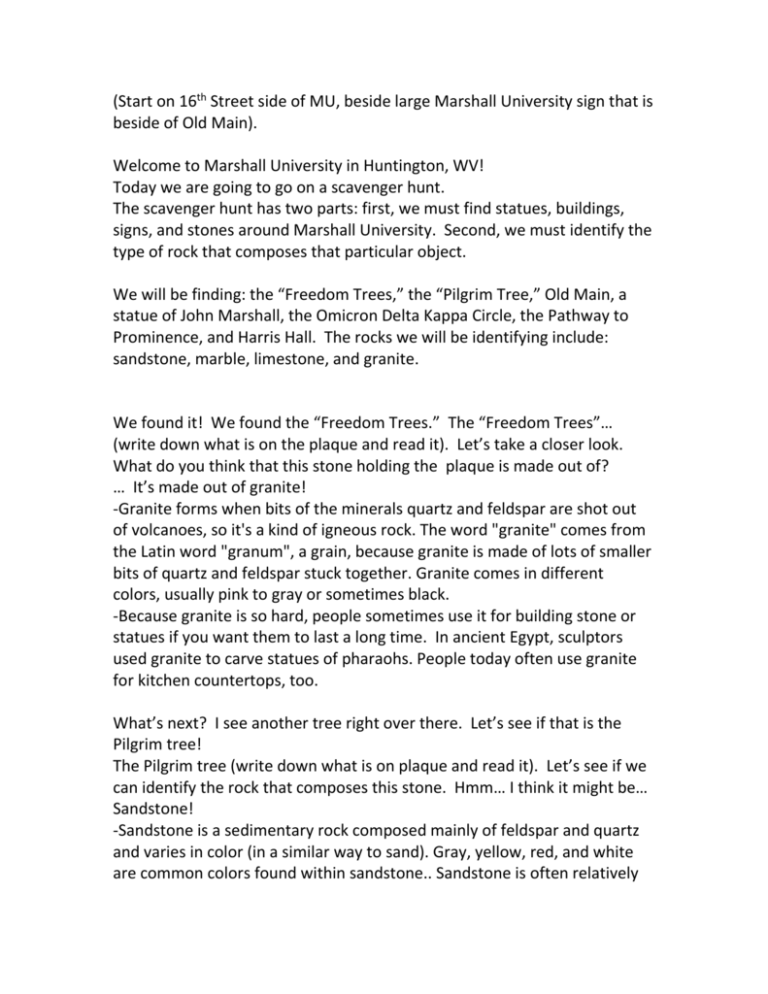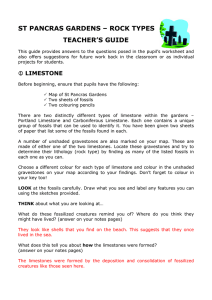VideoScript - ci350ci448project
advertisement

(Start on 16th Street side of MU, beside large Marshall University sign that is beside of Old Main). Welcome to Marshall University in Huntington, WV! Today we are going to go on a scavenger hunt. The scavenger hunt has two parts: first, we must find statues, buildings, signs, and stones around Marshall University. Second, we must identify the type of rock that composes that particular object. We will be finding: the “Freedom Trees,” the “Pilgrim Tree,” Old Main, a statue of John Marshall, the Omicron Delta Kappa Circle, the Pathway to Prominence, and Harris Hall. The rocks we will be identifying include: sandstone, marble, limestone, and granite. We found it! We found the “Freedom Trees.” The “Freedom Trees”… (write down what is on the plaque and read it). Let’s take a closer look. What do you think that this stone holding the plaque is made out of? … It’s made out of granite! -Granite forms when bits of the minerals quartz and feldspar are shot out of volcanoes, so it's a kind of igneous rock. The word "granite" comes from the Latin word "granum", a grain, because granite is made of lots of smaller bits of quartz and feldspar stuck together. Granite comes in different colors, usually pink to gray or sometimes black. -Because granite is so hard, people sometimes use it for building stone or statues if you want them to last a long time. In ancient Egypt, sculptors used granite to carve statues of pharaohs. People today often use granite for kitchen countertops, too. What’s next? I see another tree right over there. Let’s see if that is the Pilgrim tree! The Pilgrim tree (write down what is on plaque and read it). Let’s see if we can identify the rock that composes this stone. Hmm… I think it might be… Sandstone! -Sandstone is a sedimentary rock composed mainly of feldspar and quartz and varies in color (in a similar way to sand). Gray, yellow, red, and white are common colors found within sandstone.. Sandstone is often relatively soft and easy to work which therefore making them a common rock used to construct buildings. Let’s walk down this sidewalk… (along 3rd Avenue to Harris Hall). Wow, look at those rocks along the side of the building. That building is Harris Hall where students learn about subjects like history and psychology. Harris Hall is four stories high and was built in 1976. Your parents may not have even been born then! What do you think those big square columns are composed of? …You’re right if you guessed limestone! -Limestone is a sedimentary rock. It is made out of the shells of zillions of little tiny sea snails and other similar creatures. These snails and creatures lived in the sea, billions of years ago, and when they died they fell to the bottom of the sea and rotted, but their shells, which were made of calcium like your teeth, did not rot and just stayed there. Pressure from other shells, the water, and from sand being washed over the shells, squashed them all together into rock. -Limestone is also the main way you get lime, which is one of the things you make cement out of. To get lime, you have to burn limestone in lime kilns, and then what is left is lime. In the Middle Ages, people burned most of the statues of ancient Greece and Rome to turn them into lime. We have to find another building. This one is called Old Main. Here it is! Old Main was once five buildings that were joined together to make one larger building. It was completed in 1906, but one of the first parts of it was built in 1868. It is the oldest building on Marshall University’s campus! It has many offices inside of it. Let’s look at the bottom, or foundation, of the building. What do you think those rocks are? It looks like a rock we have already seen, only slightly different in color. … It’s sandstone again! This time the sandstone is lighter in color. It is a much lighter in color than the sandstone we saw before. I bet we can find some more sandstone around here somewhere… Oh wow! Look at that statue. It’s a statue of John Marshall. John Marshall was the fourth Chief Justice of the United States and the university was named after him. The statue is 8 feet tall and the base is 6 feet tall. It was completed in 1998 and cost over $100,000 dollars to make. Let’s take a closer look at the base… More sandstone! How can you tell if a rock is sandstone? Here are some helpful hints: Look to see if there are crystals. Sandstone doesn’t have crystals. Look to see if it has layers. Sandstone has layers. Look to see if you see grains of sand. Touch the rock and see if some grains fall off. You may need to use a nail to scrap some of the sand off. This is a good sign the rock you are looking at is indeed sandstone! Let’s head toward the middle of the campus… Oh, look, there’s a table in the shape of a circle. I wonder if that is the Omicron Delta Kappa circle… It is! (Write down information from table area and read). Wow, look at how polished this rock looks. I wonder what it could be? It kind of looks like a rock we have already seen, but it seems be to be a different color. What do you think it is? … It’s granite again! This time it is more pink than gray. Those are some gorgeous crystals! Here are some hints for identifying granite: Granite has crystals, but no layers. It is mostly light-colored to light gray. If it scratches glass as well, then it is likely granite. The only place left to find is the Pathway to Prominence! And if you’ve been keeping track, there is only one rock we haven’t found yet. Here is the Pathway to Prominence! The people featured along this pathway have each donated over $1 million dollars. That’s a lot of money. Some of these names look familiar, like Joan C. Edwards and John Deaver Drinko. This path was completed in 2002. But what is it made out of? The rock is a very dark green color. I bet they used green to symbolize Marshall University’s school colors. Do you know what it’s made out of yet? … It’s marble! A rare, dark green marble at that. -Marble is a metamorphic rock made out of limestone. When limestone is subjected to tremendous pressure for a long time (like if limestone is buried under a lot of other rock or an ocean) it gets squashed into marble. Marble is more beautiful than limestone and tougher, and so people like to use it for buildings. -But marble is also rarer, and more expensive. A lot of marble is white, but marble can come in all different colors. In ancient Greece and Rome, people used marble to make statues, and they used colored marble in patterns to make hard floors that would last a long time. That concludes our scavenger hunt around Marshall University! We hope you enjoyed looking at all the different places and rocks. Maybe one day you’ll go to college here!











